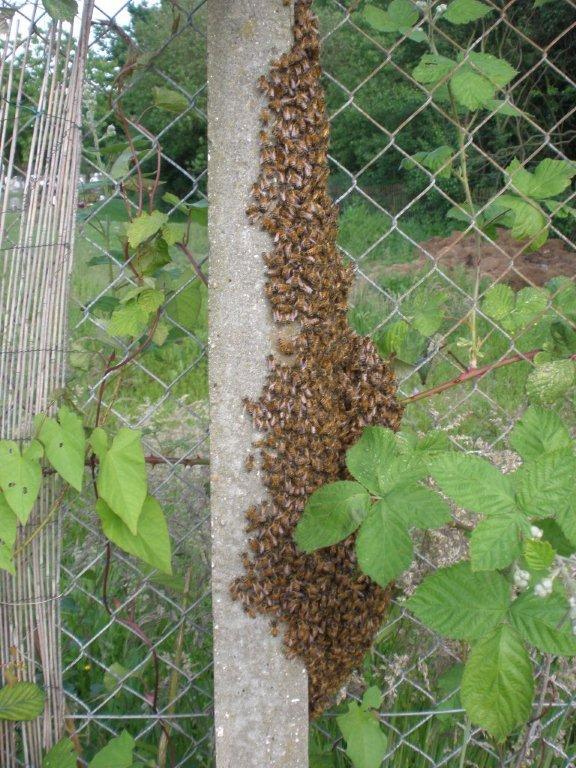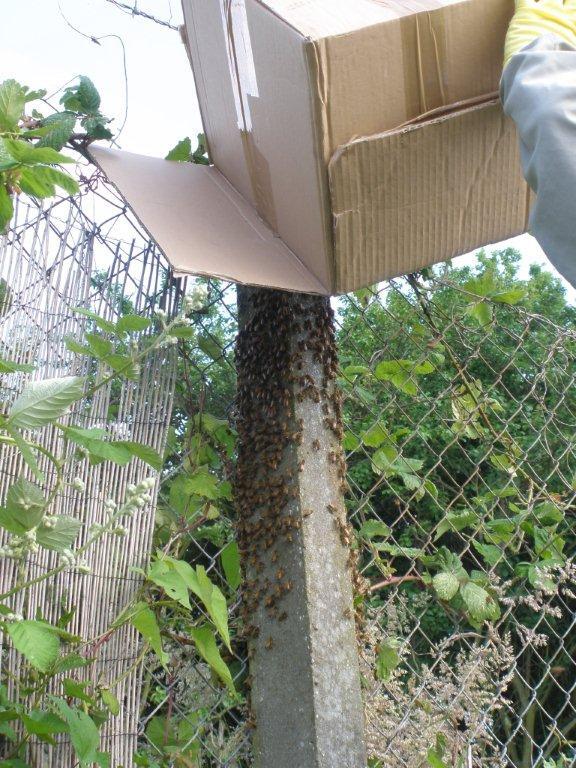Introduction to Honeybees
 |
 |
 |
 |
The first thing to be able to do is to recognise a honeybee and distinguish it from other things that go buzz. The photographs above should help. The last one is a bit more difficult!
When you have mastered this first step, below is where they live on Addison Gardens allotment. Andy Watters, our resident bee expert will keep us up to date with the comings and goings!
|
|
 |
 |
 |
 |
 |
 |
 |
May 16th 2010.
As you may be aware, this is traditionally the time of year when honeybees can start swarming - depending on circumstances, including weather conditions, they can start swarming procedures from late April through to July/August.
They can swarm for many reasons - the queen may be old, the queen may be injured in some way, the number of bees expands rapidly and they run out of space - these are the main reasons.
Last autumn I bought a new mated queen in order to have a young and healthy queen starting off the new season in 2010 - under normal circumstances you wouldn't then expect them to swarm in their first year.
However, I found swarm cells along the bottom edge of a few frames which means that my nice new queen (cost £25) was most likely going to leave the hive along with maybe half of the worker bees. If that happened then I could kiss goodbye to any honey crop from this hive this year.
In order to try and stop the hive from swarming I have carried out a procedure called 'an artificial swarm.' Basically I am hoping to trick the bees into thinking that they have indeed swarmed and in so doing they will stop all thoughts of leaving.
What I have done is to place the existing queen in a small polystyrene nucleus (simply a small 5 frame hive) with two frames of brood and some food - made up to five frames in total. I have then placed this nucleus hive in the location of the original hive and moved all the other bees and equipment to the left in another hive - see photos.
What should happen is that the flying bees (older workers) from the original hive will fly back to the poly hive and think that there's been a swarm and stop all swarming procedures - they will then allow the queen to start laying again and all should be fine.
In the main hive (to the left) the remaining bees - young workers or nurse bees as they are called - will continue making queen cells, as they are now queenless, and they should now raise a new queen.
When she hatches out she will then need a few days of fine weather - sunny, 20C, not too windy - so that she can mate with up to 15 drones in flight - a few days later she should start laying and the hive will continue as normal. Now I will have two hives.
But that is all theory - the bees don't read the books and often like to surprise one with a contrary response. Also, the new virgin queen may not get a few days of good weather and may not mate properly.
Fingers crossed.
Back to the old queen in the poly nucleus/mini hive - the reason for them preparing to swarm is not clear to me. The queen could be injured? They certainly have plenty of space in the hive so it's not a matter of too little space. She may not have mated properly and the worker bees can sense this? It could be that there are just too many bees in the hive? Certainly they got off to a good start and there are plenty of bees in the hive. I suppose I will have to wait and see what the outcome of my manoeuvres will produce.
You may have noticed that I have placed a pollen chart on the side of the main hive - see photo for approximate colours. If you have taken the opportunity to watch the bees on a sunny day, you may have noticed the different pollen colours on the bee's hind legs - mostly yellow, off white and orange in colour. If you watch closely you may be able to see which direction they fly in to collect their pollen and nectar. Recently they were flying over the fence and into the cemetery, possibly towards the flowering cherry trees in abundance.
If you are happy to get close to them, it's best to stand off to the side and not to stand in their flight path. They have been very docile bees with good temperament - I've not yet been stung by them this season - usually when I do get stung it's my fault.
You should be able to spot the drones in amongst the worker bees - they are much bigger/fatter and have very large compound eyes. Drones are the male bees of course - and they don't sting. Their sole purpose is to mate with a virgin queen - apart from that, all they do is laze about all day and eat all the food. No analogies please! At the end of the season (Sept, Oct) the workers have no more use for them and chuck them out of the hive. They plead get back in again but are not permitted to enter - eventually they starve to death.
There are specific places where the drones congregate to wait for the arrival of a virgin queen - usually about 90 metres above a small hillock or clump of trees or some other particular feature. Often you will be aware of swallows or other birds circling overhead as they try and catch a tasty drone to eat - unfortunately you can lose your virgin queen as she can also fall victim to the swallows or swifts.
The queen will hopefully mate successfully with around 10 - 15 drones over a period of two or three good days. The drones that are successful in mating with the queen die in the process - if you are very lucky, you may see a newly mated queen returning to the hive wearing a nice new skirt - this new skirt is all the rage in bee circles and is made of drone genitalia. What a way to go!!
A June Swarm
Below are pictures of some new visitors to our site in the shape of a bee swarm. The first picture could be called the 'Beauty and Bees' (the beauty is of course Pat Marchant, Andy's partner looking very brave!). Andy is pictured is in his space suit using a high tech method of capturing the swarm and enticing them into the hive. All clever stuff.
 |
 |
 |
 |

